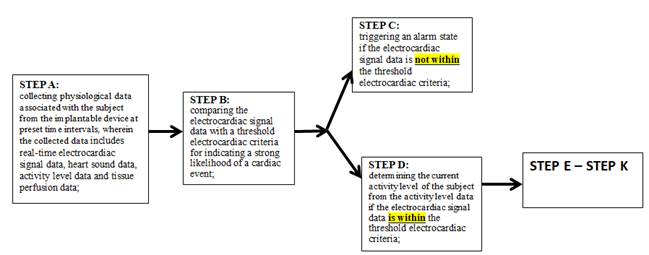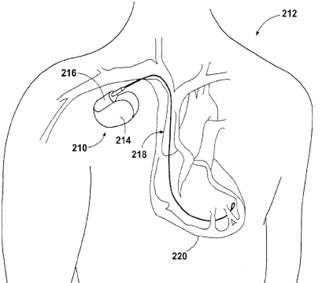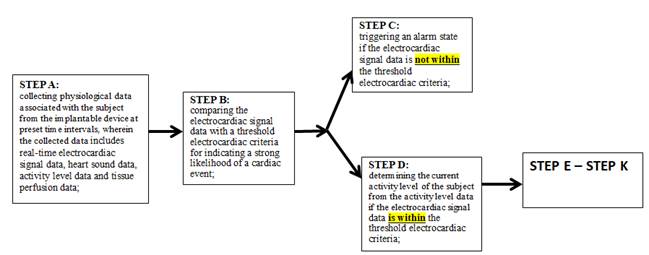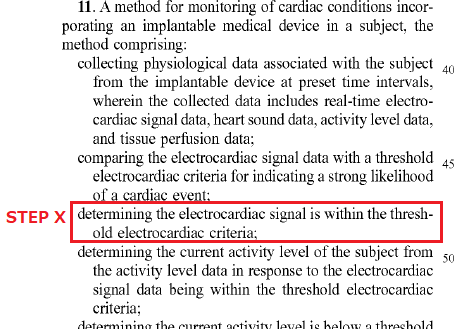
|
Ex
Parte Randal SCHULHAUSER et al. US
Application No. 12/184,020 審決日:2016年4月28日 先例認定日:2016年10月 条件付きの方法クレームのドラフティングは要注意!
Summarized by Tatsuo YABE –
2018-01-17 |
既に1年半以上前の審決ですが、最近複数の方々から質問を頂いたので紹介させていただきます。
|
PTABの審決(2016年4月28日)において条件付きの方法クレームとそれに対応するシステム形式のクレームではクレームの解釈が異なるとした。 尚、本審決は4年ぶりに先例(前回の先例認定は2013年の審決)と認定された。 依って今後の米国特許庁における条件付き方法クレームの審査に適用される。
|

|
依って、方法形式のクレームで条件を規定し、条件を満たす場合にはXを実行する、条件を満たさない場合にはYを実行すると規定した場合に、BRI(Broadest
Reasonable Interpretation)基準ではXとYの2種類の方法クレームがあり、X或いはYを開示した先行技術で拒絶される。本審決ではステップA〜Cを含む第1方法クレームとステップA〜BとステップD〜Kを含む第2方法クレームの2種類のクレームと解釈された。第1方法クレームの方が第2方法クレームよりも権利範囲が広いのでBRI基準では第1方法クレームとして審査される。ステップA〜ステップKまですべてを特徴として審査を受けたい場合にはシステム形式(means
for …ing)にクレームドラフティングするのが妥当な対応策である。(筆者)
|
****************************************************************
|
以下審決の概要:
|
問題となったクレームは心臓の生理的状態をモニターするインプラント(人体に埋め込む)タイプの装置210に関する。
|

問題となったクレームはクレーム1(方法クレーム)とクレーム11(システム形式)で、方法クレームでは、ステップCにおいてElectro-Cardiac(心電)信号が閾値(threshold)に入らない場合にはアラーム(警告)状態を引き起こすというステップがあり、次に心電信号が閾値に入る場合には活動レベルを決定し、ステップD〜ステップKに続くと規定している。PTABは最初に心電信号が閾値に入らない場合にはステップCを実行するというステップ(即ち、ステップA〜ステップCまでを特徴とする)までを方法クレームの特徴と解釈し先行技術を引用することが正しいと判断した。尚、この審決は2016年10月に先例と認められ特許庁の審査を拘束する。
|

|
|
|
Claim 1 |
Claim 11 |
|
|
A method for
monitoring of cardiac conditions incorporating an implantable medical
device in a subject, the method comprising the steps of: |
A system for
monitoring of cardiac conditions incorporating an implantable medical
device in a subject, the system comprising: |
|
A |
collecting
physiological data associated with the subject from the implantable device
at preset time intervals, wherein the collected data includes real-time
electrocardiac signal data, heart sound data, activity level data and
tissue perfusion data; |
means for
collecting physiological data associated with the subject from the
implantable device at preset time intervals, wherein the collected data
includes real-time electrocardiac signal data, heart sound data, activity
level data and tissue perfusion data; |
|
B |
comparing the
electrocardiac signal data with a threshold electrocardiac criteria for
indicating a strong likelihood of a cardiac event; |
means for comparing
the electrocardiac signal data with a threshold electrocardiac criteria
for indicating a strong likelihood of a cardiac event; |
|
C |
triggering
an alarm state if the electrocardiac signal data is not within the threshold electrocardiac
criteria; 方法クレームはここまでの特徴(ステップA〜ステップC)で審査された。 |
means for
triggering an alarm state if the electrocardiac signal data is not within
the threshold electrocardiac criteria; |
|
D |
determining the current activity level of
the subject from the activity level data if the electrocardiac signal data
is within
the threshold electrocardiac criteria; |
means for
determining the current activity level of the subject from the activity
level data if the electrocardiac signal data is within the threshold
electrocardiac criteria; |
|
E |
determining whether
the current activity level is
below a threshold activity level; |
means for
determining whether the current activity level is below a threshold
activity level; |
|
F |
comparing the
tissue perfusion data with a threshold tissue perfusion criteria for
indicating a strong likelihood of a cardiac event if the
current activity level is determined to be below a
threshold activity; |
means for comparing
the tissue perfusion data with a threshold tissue perfusion criteria for
indicating a strong likelihood of a cardiac event if the current activity
level is determined to be below a threshold activity; |
|
G |
determining whether
the current activity level is
below a threshold activity level; |
|
|
H |
comparing the tissue perfusion data with a
threshold tissue perfusion criteria for indicating a strong likelihood of
a cardiac event if the current activity level is
determined to be below a threshold tissue perfusion criteria; |
|
|
I |
triggering an alarm
state if the threshold tissue perfusion data
is not within the threshold tissue perfusion criteria; and |
means for
triggering an alarm state if the threshold tissue perfusion data is not
within the threshold tissue perfusion criteria; and |
|
J |
triggering an alarm
state if the threshold tissue perfusion data is
within the threshold tissue perfusion criteria and the heart sound data
indicates that S3 and S4 heart sounds are detected; |
means for
triggering an alarm state if the threshold tissue perfusion data is within
the threshold tissue perfusion criteria and the heart sound data indicates
that S3 and S4 heart sounds are detected; |
|
K |
wherein if an alarm
state is not triggered, the physiological data associated with the subject
is collected at the expiration of the present time interval. |
wherein if an alarm
state is not triggered, means for collecting the physiological data
associated with the subject is at the expiration of the present time
interval. システムクレームは上記全ての特徴で審査された。 |
|
PTABによると方法クレーム1をBRI基準で解釈すると、心電信号が閾値に入らない場合にはステップCの実行のみで完結しステップD〜ステップKを実行する必要はなく、心電信仰が閾値に入る場合にのみステップD〜ステップKが実行される。従って、クレーム1は2つの方法を規定している。即ち、第1の方法はステップA〜ステップCであり、第2の方法はステップA、B、D〜Kである。依って、第1の方法の方が広いのでBRI基準で判断するとクレーム1はステップA〜Cの特徴を規定していると理解される。然るに、主引例Kramer引例の改良方法はステップA〜Cを含むので侵害となるし、クレーム1は審査で引用された先行技術の組み合わせによって自明となる。
|
しかし、クレーム11はシステム形式のクレームであり、MPF形式で構成要素を規定しており、閾値を満たさない場合と満たす場合の機能を実現する手段を規定していると理解される。依って、BRI基準によってもステップD〜Kもクレーム11の構成要素と解釈される。審査で引用された先行技術を組み合わせてもステップD〜Kが現出しないのでクレーム11は非自明であると判断する。
|
****************************************************************
|
審決後に審査に戻り出願人はステップCを削除し、心電信号が閾値に入るか否かを検討するステップXに置換し、ステップD〜Kを維持し、権利化された(USP9545215のクレーム11となった)。
|

|

|

****************************************************************
|